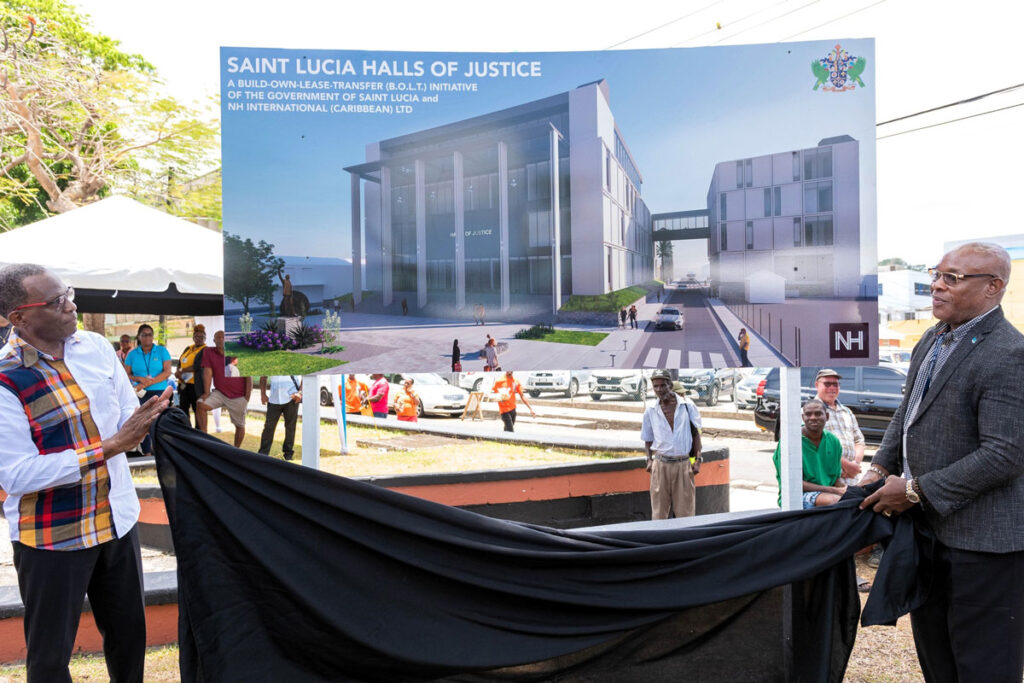
Saint Lucia is setting the pace to reform its judicial system with the unveiling of a Halls of Justice project which is estimated at a cost of $143 million. Construction works are due to be completed within a two-year period.
At a sod-turning ceremony last Friday, Prime Minister Philip J Pierre bemoaned the spread of court houses around the city. He said the accommodations provided by private landlords to accommodate current court buildings was inadequate.
The prime minister recalled that the old courthouse building was built around 1948 and 1951 after the Castries fire.
“By the 1990s it had already become inadequate for use as a court house,” said Pierre.
Compounding the matter, the prime minister added, were indoor quality issues that forced its closure. He recalled that the former administration had spent about $1million in an attempt to get the structure back into use, but it had to be closed because of air quality issues.
“Law courts are highly specialized buildings,” Pierre noted. He said they have to make provision for several services including secure parking areas for judges and staff, secure areas for prisoners, and separate areas for judges, staff, the public, and prisoners.
He said the buildings must be welcoming but secure, with separate areas for family matters. “This building will deliver all of this,” declared Pierre, while stating that government will own a modern, secure building for the courts and judiciary when the twenty-year lease ends.
Uniquely designed with an overhead pass to connect two buildings at its location, on Laborie Street, Castries, the Halls of Justice will contain four storeys and occupy two lots.
The structure will see the Civil and Family Division relocated to the old court house site, while the former site of the Ministry of Education will house the Criminal Division. The building will also consist of 14 courtrooms, six magistrate chambers, and nine judges’ chambers.
It will also accommodate eleven witness rooms, ten administrative offices, a law library, a police post, holding cells, and a high-security defendant dock.
Outlining the contractual arrangements for the structure, the prime minister explained that government has entered into a lease agreement with a Build Own Lease Transfer (BOLT) agreement with Themis – NH International.
He described the main contactor- NH International Caribbean Limited as “a reputable firm from Trinidad & Tobago (T&T) that has a long history of doing business in Saint Lucia.”
PM Pierre asserted: “It’s a building that every Saint Lucian must take pride in as an independent people. It will raise the quality of architecture, it will raise the city of Castries.
“This Halls of Justice will have exceptional value to the citizens of Saint Lucia by providing an integrated approach to address a reduction in the backlog of court cases, the increase in court spaces to provide justice, the fusion of court houses and supporting offices and environmental concerns and energy efficiency.”
Housing Minister Richard Frederick described the project as having “historical significance” towards the development of Saint Lucia’s judicial landscape.
Frederick said in the government’s efforts to curb the scourge of criminal activity on the island, it was prudent to take on a holistic approach to the task at hand. He disclosed that government contacted NIPRO – a subsidy of the National Insurance Corporation (NIC) for funding “the first ever Halls of Justice in Saint Lucia.”
Permanent Secretary in the Department of Economic Development, Paul Hilaire stated, “The Halls of Justice is not merely a building, it is a beacon of the government’s commitment to uphold the rule of law and improve access to justice for all of our citizens.”
In the quest to establish “fairness, equity and public good”, government liaised with several entities, namely, the Eastern Caribbean Supreme Court, the St Lucia Bar Association, the Magistracy, the Ministry of Justice and the Court Administration among other stakeholders.
The design process will be undertaken by NH International with supervision provided by NIPRO and oversight responsibility managed by the Department of Economic Development.
“This multi-agency collaboration presents a structure that ensures longevity, functionality, and adaptability to the evolving means of our Justice System,” PS Paul said.













